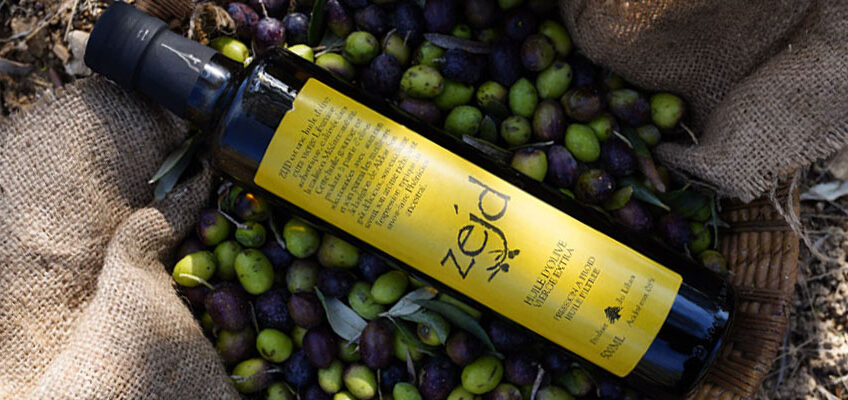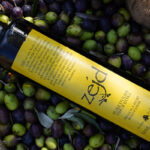Ever wondered what makes for extra virgin olive oil’s top quality, fragrant flavors and heath promoting properties? The secret lies in the delicate and intricate production process that preserves most of the goodness of the finest olives used to make it, and guarantees the highest quality in the final product! As a basic principle, extra virgin olive oil is processed mechanically, using cold-extraction techniques, without the use of heat or chemical solvents. But the transformation of olives into liquid gold takes a coherent step-by-step approach:
- Harvesting the olives
The journey begins in the olive groves, with the harvest (by hand or mechanically), whereby olive fruits at their ripe stage are collected off the olive trees onto harvesting nets. It is critical to only select unbruised fruits and disregard any damaged or deformed fruits by insect infestation (olive fruit fly) to preserve quality.
Harvest time usually goes from October to January. It starts with picking green olives and continues as the olives ripen to a dark color. Green olives produce pungent and slightly spicy oil with a fresh green fruitiness. As the olives get darker, the oil becomes sweeter with a mature fruitiness.
- Transporting the olives to the mill
Harvested olives are transported to the mill in open cases to ensure the olive oil produced is as fresh as possible. It is recommended that the olives are processed within 24 hours of harvesting to avoid oxidation or fermentation. This is referred to as same-day extraction and guarantees the freshness and high quality of the olive oil produced.
- Washing the olives
After de-leafing the olives at the mill to remove any left stems, leaves, twigs…, the olives are weighed and thoroughly washed with water to remove dirt, pesticides…
- Crushing the olives into paste
Washed olives are mashed into a paste at a 27°C temperature to prevent oxidation, without any water addition to prevent emulsion. Crushing breaks down the flesh and seeds of the olive fruit into a paste to facilitate extraction of olive oil.
- Malaxing the olive paste
The homogenous olive paste then goes to the malaxer, where it is slowly stirred for the oil droplets to accumulate and separate from the pulp. This is the stage at which olive oil develops its characteristic aromas and flavors.
- Extracting the olive oil
From the malaxer, olive paste is brought to the centrifuge to separate the oil from the solid phase of crushed olives and the wastewater. The ideal temperature for olive oil extraction is 27 °C to maintain its quality.
- Testing olive oil quality
The freshly extracted olive oil is evaluated through physico-chemical and organoleptic assessments and graded according to international standards to validate if it qualifies for ‘extra virgin’ classification.
- Storing the olive oil
The graded olive oil is then stored in stainless steel tanks under inert gas, away from oxygen and light at 18 degrees Celsius, to prevent quality degradation; and set aside for decanting, using gravity to separate any remaining impurities or solid materials from the extracted oil. Finally the oil can be filtered, if desired, ensuring its purity.
- Packaging the olive oil
Stored graded olive oil is usually resampled and tested before bottling to ensure no oxidation has occurred. The oil is then filled through integrated oil bottling lines into opaque glass bottles, considered the best type of olive oil containers for preserving oil quality, protecting it from UV and heat damage, and extending its shelf life. Such well-processed and bottled olive oil can remain fresh for up to 2 years when unopened.
Extra virgin olive oil is the toughest and most expensive grade of olive oil to produce as it is governed by the most strict chemical and organoleptic standards. However, anyone who has tasted high-quality extra virgin olive oil knows it is worth all the trouble! Besides, it’s the healthiest cooking oil of all…







Leave a Reply